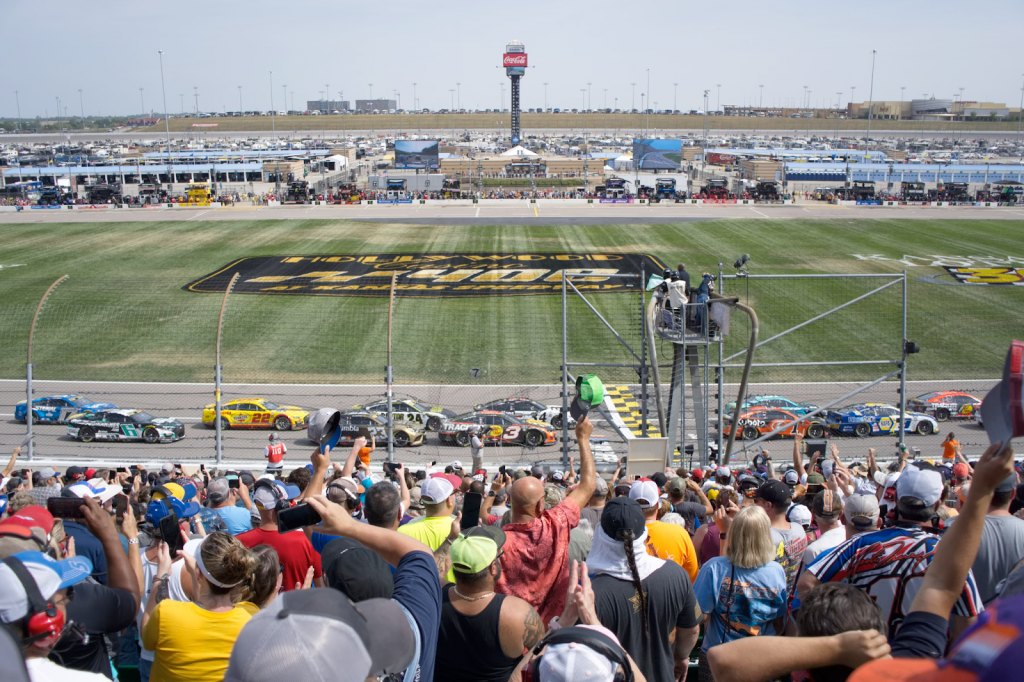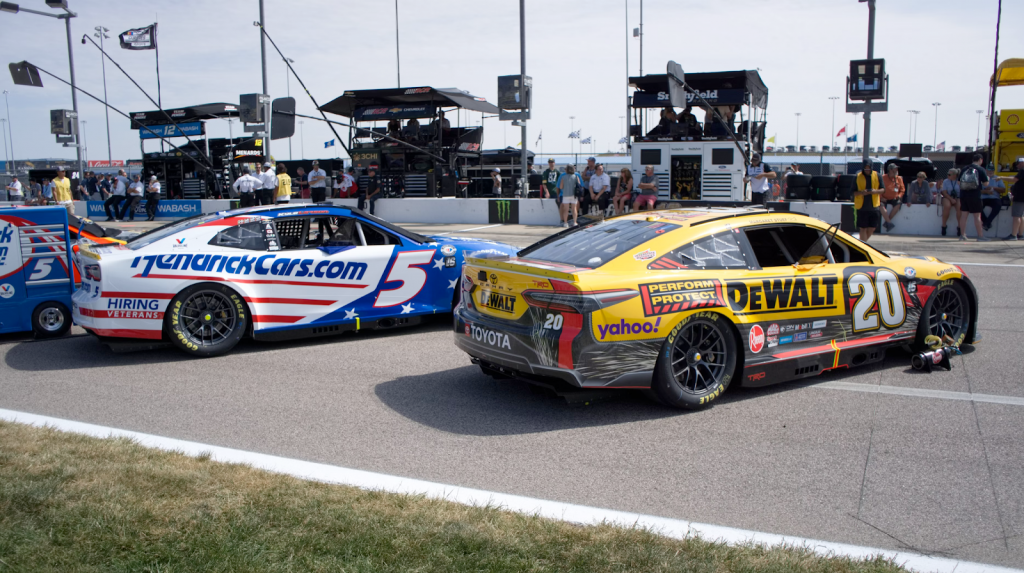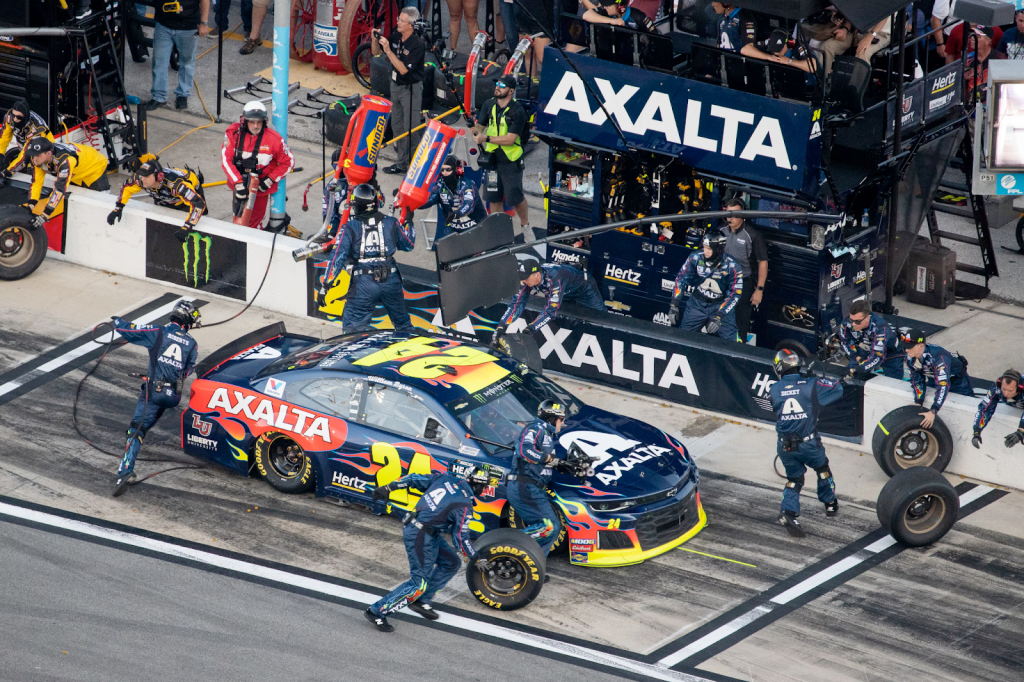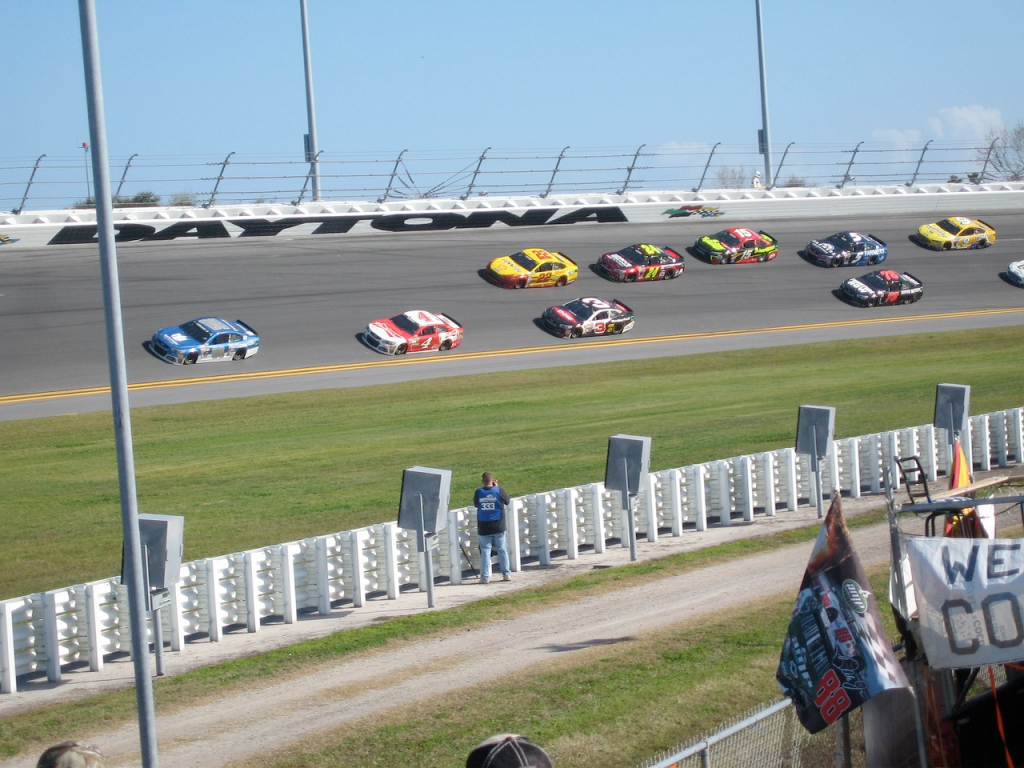
Chances are, you’ve heard of NASCAR, but you may not know much about the sport besides the fact that the cars go fast, turn left, and get into gigantic crashes. With the occasional NASCAR story sneaking onto news feeds, you probably also have some questions. Do Pitbull and Michael Jordan really own NASCAR teams? Do the drivers really only turn left? And how stock are these “stock cars,” anyway?
The short answers to these questions are “Yes”, “No”, and “Not in the slightest.” The long answers, plus a whole lot more, are what I’m here to explain. Welcome to the first of a four-part series exploring the world of NASCAR. This article will be a general primer, while parts two, three, and four will explore the drivers, the tracks, and the rules, respectively.

The Cars
A NASCAR Cup series “stock car” is about as far from a dealership car as possible. Cup cars weigh in at 3200 pounds with nearly a ton of extra aerodynamic downforce, and are powered by a 6 liter V8 engine that produces nearly 700 horsepower. These engines are paired with 15” brakes, allowing these cars to accelerate to high speeds and stop quickly.
The car body is made of carbon fiber composites which are more resistant to deformation than metal bodies. The combination of grip and power means that Cup cars can reach 200 miles per hour, while the composite bodies mean that cars can get into minor scrapes and still remain competitive. It’s rare to find a race-winning car without at least some paint scratches and tire marks.
Cup cars also have extensive safety features to protect drivers during crashes. They range from the obvious, such as reinforced roll cages, to the technical, like carefully engineered front and rear clips built to absorb energy. Every part of the car is designed with safety in mind. Even the roof flaps that open up when a car begins to spin are there for safety.
This safety-first mentality makes NASCAR the safest major motorsports series. Despite the massive crashes, more drivers miss races because of injuries sustained from off-track hobbies than because of injuries sustained in a NASCAR race.
The Drivers
Behind the controls of these brilliantly-engineered cars are some of the planet’s greatest drivers. Virtually every driver to start a NASCAR race has performed at a high level in some other series, and all of them have been driving race cars since well before they could legally drive a road car. Most NASCAR drivers have experience across several disciplines of racing, from dirt tracks to open-wheel cars.
Though many veterans, such as Jeff Gordon, Dale Earnhardt Jr. and Tony Stewart, have retired from full-time driving in the last decade, NASCAR in 2024 has no shortage of names and personalities. There’s the defending champ Ryan Blaney; the 2020 champ and most popular driver Chase Elliott; the villains, three-time Daytona 500 winner Denny Hamlin and two-time series champ Joey Logano; the veterans such as two-time champ Kyle Busch and 2017 champ Martin Truex Jr.; the underdogs like Michael McDowell, and even the happy-go-lucky watermelon farmer turned checkers-or-wreckers championship contender Ross Chastain. With thirty-six drivers on track, there’s plenty of contenders to cheer for.

The Teams
No NASCAR driver could race without a full team behind him. Some crew members are more visible than others, but all of them are vital to every race win. Here’s a few of the more important at-track team members:
Crew chief: This is the first crew member you’ll hear about. The crew chief sits on top of the team’s box on pit road, deciding on race strategy, when to pit, what adjustments to make to the car, and all the long-term details that can give a driver an edge.
Spotter: The spotter sits high above the track on top of the grandstands with binoculars to watch the race. They give drivers valuable information about where other cars are, what lanes other cars are driving in, which cars are gaining/losing time and anything else the driver needs to know.
Pit crew: These are the people who jump over the wall during a pit stop. There are five pit crew members: A front and rear tire changer, a tire carrier, a jackman and a fueler. They must change all four tires, fill the car with fuel, and make mechanical adjustments – all in under fifteen seconds. To say their jobs are high-pressure would be an understatement.
Car chief: Where the crew chief deals with in-race planning, the car chief deals with pre-race planning. They lead the engineering team and before a race will make sure everything on the car is optimized for performance while still meeting NASCAR’s stringent inspection policy.

The Tracks
The NASCAR Cup series season lasts from February into November and consists of 36 points races plus a few exhibition races. In 2024, NASCAR will host points-paying races at 26 unique tracks. Most tracks are ovals, but every track on the schedule is unique. Short ovals under a mile long require constant aggression with drivers using their bumper to help make passes. Longer ovals emphasize strategy, adaptability, engineering and less all-out aggression. Five road courses bring a unique challenge with each composed of varied turns requiring patience, skillful driving and turning right. They even hold a race on the streets of Chicago’s park district.
The most unique type of track on the schedule are the superspeedways. These large ovals are designed for maximum speed, and because drivers never have to get out of the throttle, winning one of the six superspeedway races requires drafting.
Drafting is when one car drives very close behind another, making the trailing car push through less air, experience less drag, and thus go faster. Superspeedway races typically have two or three lines of drafting cars pushing each other, and with so many cars so close together, this type of racing requires everyone to be at their best to navigate to the front without crashing.
What to Know
The 2024 NASCAR season is about to begin, with the Daytona 500 happening on Sunday, Feb. 18. As one of the aforementioned superspeedways, Daytona always brings an exciting opening to the points-paying season. If you choose to tune in, here are some storylines to watch for:
- Defending champion Ryan Blaney is looking to be the first driver to win back to back titles since Jimmie Johnson won five straight from 2006 to 2010. His teammate Joey Logano won the title in 2022 and 2018.
- Kyle Larson has won on nearly every track he’s driven on in every discipline he’s tried, including a 10-win championship year in 2021. Now entering his 11th full-time season, he’s becoming a veteran and will doubtlessly be a championship favorite again this year.
- NASCAR decides a champion using a unique playoff system, in which sixteen drivers compete in the final ten races and gradually get whittled down until four drivers fight for the championship in November. With the field having more parity than ever, competition for the last of those sixteen spots will be incredibly tight this year.
So, whether you become a diehard fan who watches every race from Daytona to Phoenix, or if you just tune in sometimes to see the wrecks, NASCAR has something for everyone, and much of what turns a casual fan into a lifelong viewer is getting to know the stories of the drivers. Part 2 of this series will dive into the field of 36 fulltime cars, getting to know the drivers, the stories, and the expectations for 2024.
